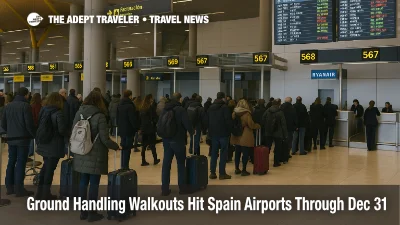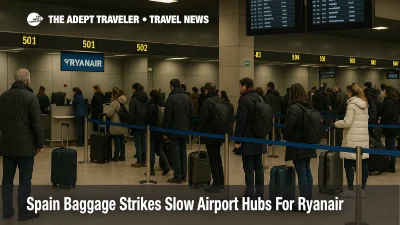Córdoba, Spain

Nestled in the heart of Andalusia, southern Spain, Córdoba is a captivating destination that seamlessly blends a rich historical tapestry with vibrant modern culture, making it an irresistible choice for discerning travelers. When you travel to Córdoba, you step into a city where every narrow cobblestone street and sun-drenched plaza narrates a story of its glorious past. Known for the stunning Mosque-Cathedral of Córdoba, an architectural marvel that juxtaposes Islamic and Renaissance design, this city is a timeless symbol of cross-cultural harmony and grandeur. Beyond the architectural splendors, Córdoba, Spain offers lush patios brimming with vivid flowers, especially dazzling during the annual Courtyard Festival. This sensory feast is further enriched by the aromatic allure of traditional Andalusian cuisine, which you can savor in the myriad charming tapas bars and restaurants scattered throughout this historical city. The enchanting maze-like districts, particularly the ancient Jewish Quarter with its labyrinthine alleys and quaint whitewashed houses, evoke a bygone era while catering to the curious traveler with modern amenities and boutique experiences. When you travel to Córdoba, Spain, your journey is enhanced by an array of cultural festivities, art galleries, and flamenco shows, offering an authentic glimpse into Andalusian cultural life. The UNESCO World Heritage Sites, including the ancient Roman Bridge over the Guadalquivir River and the historic Medina Azahara, further reinforce Córdoba as a destination of unparalleled historical significance. Whether you’re an intrepid explorer delving into the city’s multifaceted history or a leisurely wanderer soaking in its Mediterranean charm, Córdoba, Spain promises an unforgettable adventure where the past and present harmoniously converge. Plan your next travel to Córdoba to experience a city where history, culture, and beauty exist in perfect synergy.
The History of Córdoba, Spain
Córdoba, a gem tucked away in the heart of Andalusia, is an absolute marvel for those passionate about history and culture. When you travel to Córdoba, you embark on a journey through time, discovering a city that has been a confluence of great civilizations for over two millennia. This vibrant city, with its cobblestone streets and historic architecture, offers a unique glimpse into Spain’s glorious past, making it an unmissable destination for any history enthusiast.
The city’s origins trace back to ancient Iberian and Roman times, when Córdoba was originally founded as a Roman settlement in the 2nd century BCE. With the arrival of the Romans, Córdoba, Spain quickly evolved into an affluent city, celebrated for its strategic importance and opulent lifestyle. Ruins of the Roman temple, bridge, and amphitheater are still visible today, recounting tales of the city's grandeur. Traveling through Córdoba feels like stepping into an open-air museum where every corner reveals remnants of its illustrious Roman heritage.
Yet, if there is one period that stands out in Córdoba's history, it is the era of the Caliphate. During the 8th to the 10th centuries, Córdoba was the capital of Islamic Spain and one of the most significant cities in the medieval world. Under the Umayyad dynasty, it became a beacon of knowledge, culture, and architectural splendor. The city's crowning jewel, the Mezquita-Catedral, once the Great Mosque of Córdoba, encapsulates the city’s rich Islamic heritage. As you plan your travel to Córdoba, Spain, this UNESCO World Heritage Site must top your itinerary, offering an awe-inspiring glimpse into Islamic art and engineering.
Beyond its Islamic golden age, Córdoba, Spain continued to flourish, leaving behind a layered tapestry of Christian and Jewish influences. The Jewish Quarter, with its narrow winding streets and the beautifully preserved 14th-century Synagogue, speaks volumes about the once-thriving Jewish community. Moreover, the majestic Alcázar de los Reyes Cristianos, a medieval fortress used by Christian monarchs, showcases Córdoba’s Christian legacy. As you travel through Córdoba, the seamless blend of these diverse cultures and religions offers an enriching and holistic travel experience, making Córdoba, Spain a must-visit for anyone with a keen interest in the chronicles of human civilization.
The Culture of Córdoba, Spain
Located in the heart of Andalusia, Córdoba, Spain boasts a rich tapestry of history, culture, and modern sophistication. When you travel to Córdoba, you're not just visiting a city; you're diving headfirst into a living museum where the past and the present elegantly intertwine. The charm of Córdoba lies in its narrow cobblestone streets, astonishing architecture, and warm, welcoming people—factors that create an inviting atmosphere unlike any other destination.
Historical Significance and Architectural Wonders
One of the undeniable reasons to travel to Córdoba, Spain is to experience its wealth of historical landmarks. The Mezquita-Catedral, a UNESCO World Heritage Site, stands as a testament to the city's diverse cultural influences, from Roman to Visigothic to Islamic and Christian. Walking through its arches is like traversing time itself. Besides the Mezquita, the Alcázar de los Reyes Cristianos and the Roman Bridge are other iconic structures that offer a glimpse into the city's multifaceted past. These architectural feats not only exemplify Córdoba's historical importance but also its role as a cultural melting pot.
Vibrant Street Life and Festivals
Córdoba, Spain is known for its vibrant street life and numerous festivals that draw visitors from around the world. The Courtyards Festival, or "Fiesta de los Patios," held every May, showcases the city's beautiful, flower-filled patios, adorned with stunning arrays of geraniums, carnations, and jasmine. Another significant event is the Festival of the Crosses, where elaborately decorated crosses made of flowers are displayed in public squares. By choosing to travel to Córdoba during these festivals, you immerse yourself in the city's lively traditions, mingling with locals and experiencing firsthand their zest for life.
The Culinary Delight and Local Traditions
Córdoba's culinary scene is a delightful mosaic of flavors and traditions. The city's gastronomy is heavily influenced by its historical tapestry, offering a unique blend of Moorish, Jewish, and Christian culinary practices. Traditional dishes such as Salmorejo—a refreshing tomato and bread-based cold soup—and Flamenquín—a rolled and breaded dish typically filled with ham—are staples you must sample. Tapas culture is vibrant here, with various bars offering a multitude of small dishes that encourage socializing and embodying the leisurely Andalusian lifestyle. Traveling to Córdoba thus becomes an adventure for your taste buds as much as for your soul.
Warm, Hospitable People
What truly rounds out the experience when you travel to Córdoba is the warmth and hospitality of its people. The locals are known for their friendliness and willingness to share their culture and traditions with visitors. This makes Córdoba, Spain not just a destination but a place where you can feel at home, even when you're miles away from your own. Engaging in conversations with the locals, participating in their festivities, or simply enjoying a quiet evening at a local café can enrich your travel experience in countless ways.
By deciding to travel to Córdoba, Spain, you are opening yourself to a blend of historical richness, cultural vibrancy, and unparalleled hospitality. Whether you're wandering through its ancient streets, partaking in lively festivals, savoring local delicacies, or connecting with its warm-hearted people, Córdoba offers an unforgettable travel experience that is both enriching and soul-satisfying.
The Food of Córdoba, Spain
Travelers looking to experience an unforgettable culinary adventure should consider a journey to the enchanting city of Córdoba, Spain. Known for its rich cultural heritage and historic architecture, Córdoba also boasts a gastronomic scene that is nothing short of extraordinary. Nestled in the heart of Andalusia, this city offers a wide array of traditional dishes, modern culinary innovations, and mouth-watering street food that cater to all tastes and preferences. When you travel to Córdoba, you immerse yourself in a food lover’s paradise where every meal is a celebration of flavors and culinary traditions.
A Tapestry of Traditional Dishes
Córdoba, Spain, proudly showcases its culinary traditions through a variety of iconic dishes that have been perfected over generations. One must-try dish is salmorejo, a refreshing cold tomato soup garnished with hard-boiled eggs and Spanish ham. This locally beloved dish is particularly delightful during the hot summer months. Another notable mention is rabo de toro, a rich and hearty oxtail stew that delights the palate with its depth of flavor. As you travel to Córdoba, be sure to explore the city's historic taverns and family-owned restaurants where these traditional recipes are crafted with care and authenticity.
Modern Gastronomy and Innovative Flavors
While Córdoba’s culinary roots are deeply traditional, the city is also a hotbed for modern gastronomy. Across the city, you'll find contemporary chefs who blend time-honored techniques with fresh, innovative flavors. Many restaurants and tapas bars in Córdoba, Spain, offer fusion dishes that highlight the best of both worlds. Imagine savoring a classic dish like flamenquín, but with a modern twist, such as an infusion of exotic spices or a unique method of preparation. When you travel to Córdoba, you’ll have the opportunity to enjoy these culinary creations that redefine traditional Spanish cuisine, making your dining experience both memorable and exciting.
Street Food and Markets
No culinary tour of Córdoba would be complete without delving into its vibrant street food scene and bustling markets. Stroll through Mercado Victoria, an iconic food market where you can sample a multitude of local delicacies, from freshly made churros to gourmet cheeses. The street food in Córdoba, Spain, is equally tantalizing, offering quick bites like bocadillos (Spanish sandwiches) filled with an assortment of meats and cheeses. As you travel to Córdoba, be sure to take the time to explore these flavorful street options, which provide a delicious and convenient way to experience the local culture.
In essence, travel to Córdoba, Spain, for an unparalleled culinary journey that combines traditional tastes with modern sophistication. Whether you’re dining in an exquisite restaurant or enjoying a snack from a street vendor, the city's culinary offerings are bound to leave a lasting impression. From mouth-watering tapas to sumptuous main courses, Córdoba promises a gastronomic adventure that beckons food enthusiasts from around the globe.
What to See and Do in Córdoba, Spain
For travelers who plan to visit the historic city of Córdoba, Spain, the options are immense and varied. This captivating city, with its incredible blend of culture, history, and modern attractions, offers something for everyone. Here are ten must-do activities that will make your travel to Córdoba a memorable experience.
1. Explore the Mezquita-Catedral
No visit to Córdoba, Spain would be complete without exploring the famous Mezquita-Catedral. Known for its awe-inspiring Islamic architecture, this UNESCO World Heritage site once served as an Islamic mosque before being converted into a Catholic Cathedral. As you travel to Córdoba, ensure to take time to wander through its striking arches and intricate mosaics. Each corner of this iconic landmark tells a story of its unique past, showcasing stunning craftsmanship that has stood the test of time.
2. Wander the Streets of the Jewish Quarter
The Jewish Quarter is another essential stop when you travel to Córdoba. The narrow, winding streets are full of character and history. As you navigate through this part of Córdoba, Spain, you'll come across medieval synagogues, charming patios adorned with flowers, and delightful boutiques. This area also hosts captivating museums, such as Casa de Sefarad, which offers insights into the lives of the Spanish Jews before their expulsion in 1492.
3. Visit the Alcázar de los Reyes Cristianos
A stone's throw away from the Mezquita-Catedral is the Alcázar de los Reyes Cristianos. This fortress-turned-palace showcases opulent rooms, serene gardens, and fascinating Roman mosaics. As you travel to Córdoba, don't miss out on the opportunity to stroll through its neatly manicured gardens and take in the panoramic views of the city. The Alcázar also served as the headquarters for the Catholic Monarchs, making it an essential historical site.
4. Experience the Patios of Córdoba
Travelers to Córdoba in May can enjoy the famous Patios Festival, where local residents open their private courtyards to the public. These patios, brimming with vibrant flowers, cascading plants, and decorative fountains, offer a true sense of Andalusian charm. However, even if you travel to Córdoba outside of festival dates, many patios remain accessible and offer a quiet escape into local culture and traditions.
5. Discover Medina Azahara
Medina Azahara is an archaeological wonder located just outside Córdoba, Spain. This ancient city was built in the 10th century and considered a representation of Abd-ar-Rahman III’s “paradise on earth.” As you travel to Córdoba, a day trip to this historical site will allow you to stroll through the remains of palaces, mosques, and administrative buildings. The visitor center provides a detailed overview of the site’s significance and history, helping you appreciate the scale and grandeur of this forgotten city.
6. Stroll Along the Roman Bridge
The Roman Bridge offers another must-see experience for visitors traveling to Córdoba. This ancient structure, built in the 1st century BC, has been a vital crossing over the Guadalquivir River for thousands of years. At sunset, the views from the bridge are particularly mesmerizing. A walk along the Roman Bridge provides not just a historical perspective, but also a scenic view of Córdoba’s skyline and particularly striking backdrop defined by the Mezquita-Catedral.
7. Savor Traditional Andalusian Cuisine
No travel to Córdoba is complete without indulging in traditional Andalusian cuisine. The city's many restaurants serve delicacies like salmorejo, a thick tomato soup garnished with ham and egg, and flamenquín, a breaded roll made from ham and pork. Enjoying a meal in one of Córdoba, Spain’s rustic tapas bars is an experience that brings travelers closer to the heart of Andalusian culture.
8. Explore the Museums of Plaza del Potro
Plaza del Potro is a picturesque square offering more than just beautiful architecture. It is home to two noteworthy museums: the Museum of Fine Arts and the Julio Romero de Torres Museum. As you travel to Córdoba, make a point to explore these cultural hubs. The Museum of Fine Arts hosts impressive works from Spanish artists, while the Julio Romero de Torres Museum dedicates itself to the lifework of one of Córdoba's most famous painters.
9. Enjoy Flamenco Shows
Flamenco is an integral part of Andalusian culture, and experiencing a live flamenco show in Córdoba, Spain, is a must. Venues like Tablao El Cardenal offer authentic performances where passion and storytelling come alive through music and dance. As you travel through Córdoba, attending one of these shows provides a memorable, vibrant, and deeply moving experience that captures the spirit of southern Spain.
10. Visit the Palacio de Viana
The Palacio de Viana, also known as the Viana Palace, should be on every traveler's itinerary when visiting Córdoba. This Renaissance palace is an architectural masterpiece that boasts 12 unique patios, each offering a different theme ranging from formal gardens to romantic courtyards. Wandering through the rooms and gardens of the Palacio de Viana provides an enchanting glimpse into the aristocratic life of Córdoba’s past. The palace also houses a gallery and a collection of Andalusian art and antiques.
Traveling to Córdoba, Spain offers a rich and immersive experience for history enthusiasts, culture buffs, and culinary explorers alike. Each of these activities ensures that your travel to Córdoba is filled with unforgettable moments and deep cultural connections.
Why You Should Travel to Córdoba, Spain
Travel enthusiasts often find Córdoba, Spain to be an irresistible destination due to its rich historical tapestry and vibrant cultural scene. Nestled in the heart of Andalusia, this charming city offers a compelling blend of Roman, Moorish, and Spanish influences. One cannot help but be captivated by the majestic Mezquita-Catedral, an architectural masterpiece that tells the story of Córdoba's diverse past. Wander through the well-preserved Jewish Quarter, where narrow, winding streets lead to picturesque patios and old synagogues that speak volumes of a bygone era. The Roman Bridge and the Alcázar of the Christian Monarchs add to the city's allure, making travel to Córdoba a journey through time itself.
Apart from its historical landmarks, Córdoba, Spain is a modern, dynamic city brimming with contemporary culture and vibrant festivals. Travelers often flock to experience the delightful patios during the spring festival, Festival de los Patios, when locals proudly display their artistically adorned courtyards bursting with flowers. The Feria de Córdoba, another highlight for tourists, offers an immersive experience of local traditions, dance, music, and gastronomy. Culinary delights await visitors at every corner, from traditional tapas to modern culinary innovations, ensuring that travel to Córdoba also becomes a gastronomic adventure. With excellent public transport and a welcoming atmosphere, Córdoba accommodates the needs of every kind of traveler, whether they are history buffs or modern explorers.
To truly appreciate the essence of Andalucía, you must travel to Córdoba, Spain, where past and present harmoniously coexist. This city offers an unmatched blend of historical landmarks and lively cultural experiences that make it a must-visit destination in Spain. Picture yourself standing in the awe-inspiring Mezquita-Catedral, wandering the charming streets of the Jewish Quarter, or losing yourself in the jubilant ambiance of the city's festivals. When you travel to Córdoba, you're not just visiting a place; you're immersing yourself in a unique, unforgettable experience that will captivate your senses and enrich your understanding of Spanish heritage and culture. So, pack your bags and set your sights on Córdoba, Spain for a travel experience unlike any other.
Tips & Tricks for Traveling in Córdoba, Spain
Travel to Córdoba, Spain is an enriching experience imbued with history, culture, and breathtaking sights. To help you make the most of your Travel to Córdoba, here are some essential tips and tricks.
1. Discover the Mezquita-Catedral Early
The Mezquita-Catedral, or Mosque-Cathedral, is Córdoba’s most iconic landmark. Aim to arrive early in the morning to avoid large crowds and enjoy a peaceful ambiance. Early visits also provide a unique opportunity to witness the ethereal light streaming through ancient stained glass windows, casting beautiful patterns on the mosque’s intricate arches.
2. Explore the Jewish Quarter
La Judería, or the Jewish Quarter, is a labyrinth of narrow cobbled streets and whitewashed buildings. Take your time to stroll through this historic area, pausing to admire the Casa de Sefarad, the Synagogue, and the other mesmerizing buildings. The quarter offers both historical and contemporary insights into life in Córdoba, allowing a blend of past and present to be felt strongly.
3. Stroll Around Alcázar de los Reyes Cristianos
The Alcázar of the Christian Monarchs is a medieval palace with lush gardens and impressive towers. Plan your visit in the late afternoon to avoid the midday heat. Walk through beautiful Moorish patios, and don’t miss the panoramic views of Córdoba from the top of the towers. This experience is perfect for those interested in architecture and history.
4. Savor Local Cuisine
Córdoba, Spain boasts a rich culinary tradition. Ensure to try local dishes such as Salmorejo, Flamenquín, and Rabo de Toro (oxtail stew). Visit traditional tabernas and choose places frequented by locals for the most authentic taste. The central market, Mercado Victoria, is also a fantastic spot to sample a wide variety of Spanish foods.
5. Visit During the Patio Festival
The Patio Festival, held every May, is a uniquely Córdoba event where residents open their beautifully adorned courtyards to the public. These patios are a riot of colors with potted plants and flowers adorning every available space. This festival is the perfect time to experience the city’s charm at its peak.
6. Utilize Local Transport
Travel around Córdoba, Spain via its efficient local transport system, which includes buses and a modern bike-sharing scheme. The compact nature of Córdoba makes it very walkable, but these transport options are great for reaching outlying parts of the city. This can save time and energy, especially during the hotter months.
7. Experience Flamenco
No Travel to Córdoba would be complete without experiencing Flamenco. This passionate and captivating dance can be enjoyed in various tabernas and dedicated Flamenco venues throughout the city. Some restaurants offer dinner alongside live Flamenco shows, providing an immersive cultural experience.
8. Shop for Unique Souvenirs
When you Travel to Córdoba, Spain, shopping for unique souvenirs is a must. The city is known for its exquisite leather goods, ceramics, and silver jewelry. Visit the shops within the Jewish Quarter and around Calle de las Flores for high-quality, handmade items. These make perfect gifts or personal keepsakes from your trip.
9. Take a Riverside Walk
For a relaxing break, take a stroll along the banks of the Guadalquivir River. The scenic path offers stunning views of the Roman Bridge and the Mezquita-Catedral’s tower reflecting on the water. Evening walks provide a magical backdrop as the city's historic buildings are illuminated.
10. Discover Lesser-Known Museums
While Córdoba is famous for the Mezquita-Catedral and Alcázar, it has several lesser-known museums deserving of your attention. The Archaeological Museum and the Museum of Fine Arts house significant collections that delve into Córdoba's rich history and artistic heritage, offering a quieter and more in-depth exploration of the city.
Travel to Córdoba is an immersion into a world of history, art, and culture. By embracing these tips and tricks, you'll experience a smoother, more enjoyable visit, ensuring that your memories of Córdoba, Spain are truly spectacular.
Other Places You Might Like
Travel enthusiasts who fall in love with Córdoba, Spain, will likely find immense pleasure in exploring other captivating destinations that offer a blend of history, culture, and stunning architecture.
Seville, Spain - Seville, a city brimming with rich history and vibrant culture, is a must-visit. Famously known for its flamenco dancing, Seville is host to captivating architectural marvels such as the Seville Cathedral and the Alcazar Palace, a UNESCO World Heritage Site. Much like Córdoba, Seville has a charming old town filled with narrow, winding streets and exquisite plazas. The city’s orange blossom-filled air and sparkling Guadalquivir River make it perfect for leisurely strolls or romantic boat rides, much akin to the serene experience of traveling to Córdoba.
Granada, Spain - If you have a profound admiration for Córdoba, Spain, Granada should be on top of your travel list. Known for the stunning Alhambra Palace, a spectacular blend of Islamic architecture and lush gardens, Granada offers an immersive look into Spain's rich Moorish history. Wander through the Albayzín neighborhood, a labyrinth of narrow streets reminiscent of Córdoba’s ancient quarters. The city’s vibrant tapas culture and its scenic views of the Sierra Nevada mountains create a perfect blend of historical and natural beauty, making your travel to Granada truly fulfilling.
Toledo, Spain - Toledo is another destination that will appeal immensely to lovers of Córdoba. Well-known as the "City of the Three Cultures," Toledo showcases a rich mingling of Christian, Muslim, and Jewish influences. Its ancient synagogues, mosques, and churches serve as stunning historical spots, drawing parallels to the cultural tapestry found in Córdoba. The picturesque views from the Tagus River and the city's medieval charm will give travelers a rich historical experience similar to what they’d enjoy when they travel to Córdoba.
Lisbon, Portugal - The capital of Portugal boasts a mix of historic charm and modern attractions, making it a great companion to travel to Córdoba, Spain. Lisbon offers the stunning Jerónimos Monastery, the historic district of Alfama, and the beautiful Belém Tower, all of which echo the architectural splendor prevalent in Córdoba. Wander through the city’s charming streets, explore its vibrant nightlife, or take a tram ride through scenic routes. The city, perched on seven hills and overlooking the Tagus River, provides panoramic views that are reminiscent of Spain's majestic landscapes.
Marrakech, Morocco - For those enamored by the Moorish influence visible in Córdoba, traveling to Marrakech will be a sensory delight. This vibrant city is peppered with palaces, gardens, and bustling souks. The Bahia Palace and the Koutoubia Mosque offer a stunning glimpse into Morocco’s architectural grandeur. Wander through the historic Medina, a UNESCO World Heritage site, and get lost in the vibrant atmosphere. Marrakech exudes an old-world charm similar to that found in Córdoba, Spain, making it a perfect destination for those who love exploring rich cultural histories.
Florence, Italy - Florence offers an enchanting travel experience that will resonate with anyone who loves Córdoba. This Italian city is a haven of renaissance art and architecture, mirroring the historical significance and beauty seen in Córdoba. Visit the renowned Florence Cathedral, the Uffizi Gallery, and the Ponte Vecchio bridge. Wander through narrow medieval streets filled with art, history, and mouth-watering Italian cuisine. The city’s deep cultural roots and stunning vistas will provide an equally enriching experience.
Porto, Portugal - Porto is a city that beautifully merges the old and new, similar to the inviting charm of Córdoba, Spain. Its picturesque Ribeira district, with colorful buildings lining narrow medieval streets, is a delight to explore. Visit the historic Livraria Lello bookstore, the majestic Clerigos Tower, and the iconic Dom Luis I Bridge. The Douro River runs through the heart of Porto, offering river cruises that highlight the city’s beauty, much like the Guadalquivir River does for Córdoba.
Great Mosque of Córdoba, Córdoba, Spain

Mezquita-Catedral, Córdoba, Spain

London Airport Strikes Disrupt Christmas Flights

MSC Magnifica World Cruise 2028 Booking Details

A&K - Crystal 2027 Cruise Dates for Europe, New York

Spain Airbnb Fine Hits Tourist Rental Listings

Tarifa Tangier Ferries Canceled in Gibraltar Winds

Azul Handling Strike Spain Airports Through Dec 31

Barbados And Spain Lead 2026 Villa Trends

Spain Airport Handling Strike Days Through December 31

Schengen Internal Border Checks Widespread In Late 2025

Europe Air Traffic Control Delays Worsen, Add Buffers

Ground Handling Walkouts Hit Spain Airports Through Dec 31

Portugal General Strike Cuts Flights And Trains Dec 11 2025

Europe December Strikes Hit Holiday Flights And Trains

Spain Doctors Strike Cuts Hospital Care Dec 9 12

Maltese Falcon Med Caribbean Cruises December 2025

Spain Flu Surge Brings Hospital Mask Rules

Europe 2025 Travel Rules Tighten Borders And Costs

2028 World Cruise From Miami To Athens With Azamara

Spain Iryo Rail Strike To Hit Madrid Routes Dec 5 8

New Melbourne Doha Flights Expand Europe Options

2027 Mediterranean Season Adds Egypt Yacht Voyages

Roam 2026 Tours Open For Bookings In Mexico, Europe

World Cruise Dubai To Barcelona 2029 Route Announced

Spain Baggage Strikes Slow Airport Hubs For Ryanair

Spain High Speed Rail Strike Cuts Iryo Services

